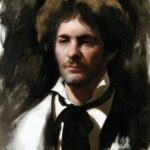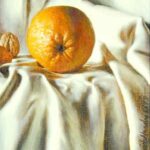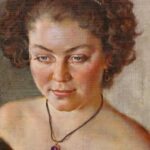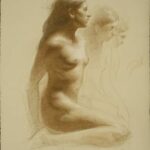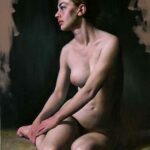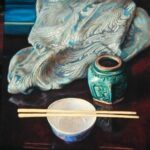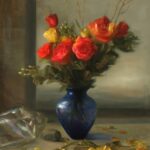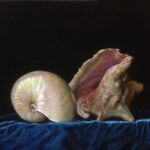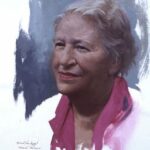
I should start by telling you how I did it. First of all, I picked one of the most respected artists and teachers in the Los Angeles area, Sergei Bongart. I was in my early twenties when I started studying with Sergei. He had a thick Russian accent. His education was also in Russia. He was considered one of the best artists and colorist. His bold brushwork was highly thought of.
In order to pay for my lessons, I had to find a way to make money. I had been trained in high school to do scenery for stage plays so I did murals for the great sum of $35 a wall. I could do them fast using a dry brush technique. At this time, you could buy groceries for a week with $35. I worked quickly using acrylic and water-based paint. I had two small boys not yet in school. My mom helped to watch them on days I had murals. I also worked at night, whenever possible, so my husband could babysit.
One of the greatest things that happened to me was meeting Hal Reed. Not only was he a great painter, but he was a knowledgeable teacher. Hal saw my talent. He worked with me giving me a good education. I taught for the Art League of Los Angeles, a highly respected school founded by Hal Reed. I taught there for many years with full classes. Hal was always searching for new horizons. He saw the need for video teaching. He started Art Video Productions. I was one of the six teachers used. Hal made over 100 tapes himself, and I made 52 tapes covering landscape, seascape, portrait, figure and floral.

I also had several articles done by art magazines, Art of the West, International Artist, Southwest Art and The Artist’s Magazine. I worked with print companies such as Portal, Leaning Tree, Bentley House and Haddad and also a company in Great Britain.
My teaching took up most of my time. I worked for several schools. The two most important schools were Scottsdale Artists’ School and the Art League of Los Angeles. My teaching gave me little time to paint for galleries so I started doing traveling workshops. These took me all over the world. The good part about traveling workshops is they are done by the travel agencies. All I had to do was the teaching and enjoy the trip. When I started to produce paintings for galleries, I did well with thirteen galleries at one time.
This is only a part of what I did to achieve my art career. Most men get their education and go to commercial art to get started. Many then go to fulltime painting, leaving the commercial art world behind. Some women do the same. I couldn’t get my education first. I just didn’t have the money. I did it anyway; the hard way.
There are many great women artists out there who are alive today and many who did well that have passed on. The answer is talent. If you are good, that may be all it takes. We all know there have been many who were just lucky, not as talented but did it anyway.
Oil Painting
Authenticity, Creativity and the Quest for a Singular Vision
Summary by Susan Blackwood OPA based on OPA 2013 National Exhibition presentation by Joe Paquet

Joe was our first speaker to kick off the fabulous weekend in Fredericksburg, Texas. His excellent, inspirational and powerful talk flew straight to the heart of the matter. It was a great way to start the 2013 OPA National Show and Convention.
“What is your goal as an artist?” This question was first presented to Joe by Don Demurs.
Joe has spent a lot of time thinking about this. Here is a brief summary of his thoughts and ideas and his reality of putting them into practice.
As artists, we make choices toward our goal or away from it. We want to be relevant and we want to be validated. Social Media seems to give us that — but does it? All that really matters is the last painting that you have painted.
Fact: we all may be artistic but are we all artists? It is all about our goal.
There are a lot of paintings “out there”. As an artist we need to only show paintings that edify and glorify ME, the artist….. then sell those paintings only. We need to bring something of worth to the world. We need to ask ourselves…. “Have I lost the connection and love in my paintings?”
Our lives are full of external pressure to produce. We are in a hurry. Are we missing the true path by not allowing our growth in our paintings to be organic and ripen on the vine. Fine Art is not really about the “packaging of our product” but about the growth of the artist. Life is a tightening spiral. With each choice one makes, the spiral of choices gets tighter and closer; Joe’s advice is to “know Yourself” and not your audience.
So, how does an artist be original with thousands of years of art history and artists that seem to have done it all?
First: Find out what skills you have and what skills you need to improve. Make a chart of the skills that you need to be proficient as a representational oil painter. On a scale of one to 10, how do your following skills stack up?
- Drawing
- Color
- Harmonies
- Design
- Brush strokes
- Values
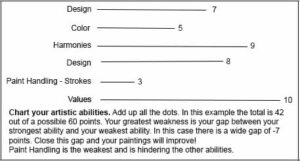
Chart yourself adding up the dots. Your greatest weakness is the gap between the strongest and the weakest dot. (Unfortunately we identify ourselves with our strengths and not our weakness.) There are lots of good artists today. However, in today’s art market the good paintings don’t get noticed anymore, exceptional paintings do get noticed. Look at your weaknesses, embrace them, make them strong and become exceptional.
Second: Paint what you love. If you love to paint apples, then paint apples. Paint passionate paintings — not “workable” paintings. Feel a bold connection to your work. Feel alive when you are painting, not just putting in time. This is not the time to be clever in front of nature, be passionate. Be YOU.
When looking at a masterpiece, don’t be swept up in the Master painter’s gift of how to make a stroke or the harmonies of color. This is his gift. Find YOUR GIFTS.
Be visceral — smell the grass — and touch the core of the subject.
Third and most important: It is not about speed or concept. It is about being willing to take a risk. Don’t be afraid to make a mistake. Technique is like… whip cream on a cinder block… it’s still a cinder block. Don’t paint like others – see the world honestly and don’t be lured by the hook of a popular style. Become the IT guy or gal by not trying to be the IT artist.
Work on your skills. Surround your self with honest people. Show no fear. Paint often. Any canvas will be scary if you only paint once every two months.
Take time to study your subject. Be visceral — smell the grass — and touch the core of the subject. Creativity is natural to every human; use that basic instinct.
Maybe you get to paint for one hour a week in the basement after the kids are asleep. So do it with passion. Tell the world about what you love, with no apologies. Our own thoughts come back to us in majesty. Paint what you paint with passion.
“Trust thyself: every heart vibrates to that iron string.” This is generally stating that if you trust yourself, then you can truly be content in whatever you do or wherever you go. “What I must do, is all that concerns me, not what people think.” Emerson – Self Reliance
Pay attention to this!
Joe’s own journey
As he grew in his own direction and passion, his work became more specific to his personal passion. In his case, he discovered the more he painted his passion, it increasingly made it more impossible to make his galleries happy. Instead he realized that he needed a dealer to sell his work. Then he could paint what he loved. He started painting his passion: the old neighborhoods, industrial sites, etc. He painted with joy and love. The desire makes a difference and the single most beautiful reason that anyone should paint. Essentially, it’s a choice — one that requires courage and skill.
If you are painting landscapes, “Talk to the landscape” — Jack Larson
Be true to yourself, surround yourself with support that has your best agendas at heart. Your support system must understand your heart.
Likewise. Tell artists when you like their art. Don’t feel threatened or be afraid. Tell them and be graceful. Treat each other well. Everything that we do in our lives is important. EVERYTHING MATTERS. All negative thoughts count. Be honest about your art. Even Whistler became sullen one night, took a candle to his paintings and lamented, “I should have drawn more.”
Do you have unity in your work or is it all over the place? Is the growth of your paintings an organic path or is it sporadic growth?
Theme is irrelevant. Only paint that which brings you joy. Only show the world your best passionate paintings. Some paintings will be blessed and some will fall by the wayside. Always ask yourself, “how many of these paintings of mine should actually go out the studio door?”
Two years ago, Joe took this all to heart. He got off the treadmill and started only painting from his passion. He told us that sometimes, regardless of the passion, they don’t sell. That is when he needs his supportive people the most. Yes, he has hit deep holes and high pinnacles. We all do.
Put your vision out there, this is what is meaningful to people.
Put your vision out there, this is what is meaningful to people. Like music, paintings should have all manner of emotions but be easy on the “ears.” Speak the most profound intimate speech but with a common language. Uncommon beauty has the greatest growth and life.
Joe Paquet is a nationally recognized, award winning artist. He is a Signature Member of the Plein Air Painters of America, the Salmagundi Club and an Out-of-State Artist Member of the California Art Club. Click here for more information on Joe Paquet.
Thank you, Joe for an uplifting lecture. You inspired us all to grow. I know that I plan on reading the notes of your lecture often, so I will take them to heart!
Classical (Classic) Realism – Part 3

In this final part of the interview, our interviewees consider the importance of having a knowledge of art history and of the arts, how to encourage creativity, and why art students should attend their schools.

Why is it important for an artist to have a knowledge of art history?
Angel: Edmond Burke, the English 18th-century philosopher, wrote that those who don’t know history are destined to repeat it (‘s mistakes). Why waste one’s time re-living the failures that led to the understanding of compositional and technical principles? The paintings of the past are inspirational and instructive, and paintings are painters talking to each other over the centuries.
Aristides: It helps to have a context for human achievement. Being an artist is a very difficult calling (for all but a few). It is a source of real encouragement to see the artists of the past, not as gods, but as real people like ourselves with hardships and struggles. A knowledge of art history can brush away the dust of the past and help us see ourselves in a bigger picture.
Hardy: Art history gives us clues, as artists, of who we are, what we are, why we are, and how we got that way.
How can parents best aid and encourage the development of their child’s imagination and creativity?
Angel: Send them to a good school.
Aristides: Limit media, provide plenty of opportunities to be outside experiencing nature, and provide exposure to the arts. This is harder then it seems, parents are under a lot of stress – it is difficult to role model a life of imagination when so few of us have the time, resources and support to do so ourselves.
Hardy: By encouraging children, when possible and appropriate, to make decisions. Also by accepting, respectfully, childish outreach into the unknown by means of fantasy.
Can creativity be taught, if so, how?
Angel: Creativity cannot be taught, but it can be nurtured. All human beings are more or less creative. What modern artists need is technical instruction, philosophy and art history.
Aristides: I don’t think it can be taught as much as encouraged and fostered. The environment needs to be stimulating while providing space and time.
Hardy: By helping the individual to accept themselves and dare to make decisions.
Why are the fine arts (painting/sculpture) important?
Angel: Life without the arts – drawing, painting, theater, novels, films, dance – would be bleak indeed.
Aristides: It has many functions and is important for a multitude of reasons. The fine arts provide us a glimmer of an alternate truth – that there is more to a human life than progress or acquisition. We have an innate love of beauty, learning, challenge. and encouragement which can be provided through art. Fine art provides us with a different vision and something greater, something noble to strive towards that can last through the passage of time. It holds up a mirror to our society and is the expression of our culture and becomes a legacy for future generations.
Hardy: Because the fine arts are a part of the total human range of responsiveness with which we as humans are endowed. Not only are painting and sculpture important, but also music, dance, drama and literature are part of the gift with which we are endowed. Much like the fact that muscles grow and function more fully for us in proportion to being used, so our involvement with the fine arts becomes more enriched and rewarding when we open up to it.
Are art and beauty synonymous?
Angel: No
Aristides: I think we would be hard pressed to say that.
Hardy: I think this depends upon how we perceive art and how we perceive beauty. “Beauty is in the eye of the beholder”. Artists of the Ashcan School responded to the beauty of simple, everyday things and happenings. But that does not forbid me my love of the miraculous beauty of a rose.
How do you encourage and help your students find their own creative path?
Angel: We make them aware of the myriad paths within the discipline of Representationalism. We do this by teaching them technique, the play between Conceptualism and Empiricism, the dialectic between the real and the abstract and a study of art history. We also encourage the students to copy paintings (contemporary, as well as pre-21st-century ones) and explore (absorb?) these various voices.
Aristides: We have a fourth year in our Atelier – a thesis year, where students work with mentors (high achieving professionals in the field) as role models. Students put together an artist’s statement, formulate a plan for a body of work based solely on their artistic vision and have an academic year to create it. The work is then placed on exhibition. We then arrange for the graduates to have their first professional show within a year after leaving the program.
Hardy: Belief in and acceptance of one’s self is crucial, in my opinion, as a bedrock for creativity. Combine this with the daring to make decisions – to be able to choose the superior between two whatevers that are almost equal, almost identical, is also important. Sometimes it is better to replace “why” with “why not?” When planning student projects, I prefer to have students take responsibility and try out their ideas. If a certain set-up is not quite working. I suggest some possible advice, but it is up to the student to reach final decisions. Even if (very rarely) something doesn’t work, there is much that can be learned that will enrich future projects.
Why should art students attend your school?
Angel: I honestly think that we are one of the best. As well as thorough training, we have Florence and the rest of Italy to draw on (Rome is an hour and a half away by train, and Venice is three hours away). The atmosphere at Angel’s is convivial and friendly, while the quality of instruction is very high – all one has to do is look at the student galleries on our website: www.angelartschool.com/galleries.html. In addition, we are one of the very few academies that teaches the business side – professional painting means painting for a living – as well as the creative.
Aristides: Art students should attend some form of rigorous education to become challenged to produce their best work. There are many great schools out there right now. Aristides Atelier is located in Gage Academy: www.AristidesAtelier.com and as such we benefit from a lot of cross fertilization.
Hardy: Because we help and encourage students in how to be effective in their artwork, understand themselves better and prepare for today’s professional art world. We train champions. The core of good instruction, in my opinion, should be accessibility and effectiveness (another way of saying dependableness). In line with this way of thinking. I have in many instances invented my own ways of presenting time-proven traditional art technology. The School of Boston did not have a strangle hold on important art procedures and viewpoints. My training came down to me from the Julianne Academy in Paris, plus the Royal Academy in Brussels and the Superior Institute in Antwerp.
Four must-see videos
Tips for Entering National Shows
An Emotional Roller Coaster for Oil Painters.
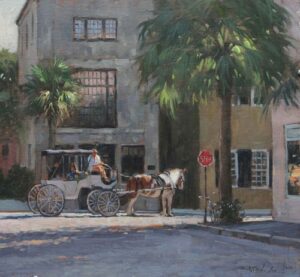
But the draw backs for some artists is that if they are not accepted they may stop entering all together. I have had the same frustration when entering what I thought was my very best work and then being fed a huge slice of “Humble Pie” in the form of a rejection. As an illustrator I learned quickly that you can’t wear your heart on your sleeve. You feel bummed out for a day, then you get back up and enter another show. Your best revenge is getting better, not getting ticked off at the judge or the show. This business is a roller coaster with big dips and big highs. One big success can erase a 100 failures. Failure is an opportunity to raise the level of your art, but if you get ticked off and blame it on politics, you will set yourself back.
Presenting your best work.
Throughout the course of a year I try to plan ahead and give myself enough time to do a painting for a show. You wait till the last minute it may not be your very best effort.
When we create a great painting there is a difficult decision whether to hold back the piece for an upcoming show or get it out to your gallery, because you know it will sell.
If you are trying to make a living in this business you have to sell paintings and when bills come with relentless regularity, it is very hard to hold back your best work. However some paintings are very salable in a gallery, but may not be show paintings. Figures can be a tough sell in a gallery depending on the artist, but they can make quite a statement in a national show. The level of expertise in all the principals of painting has to be very high. Whatever you enter it has to be your very best.
Showtime.
Ok, so you get in the show. Your happy and now you have to ship your painting to the gallery on the due date. The expense is starting to mount with entry fee and shipping both ways.
Not to mention travel expense to the show if you want to attend the opening. Attending openings is very important and I don’t do it enough. As an artist, you have the opportunity to meet new collectors and fellow artists. Our occupations are sort of hermit-like, so to get out and talk with people is good for the soul and the career.
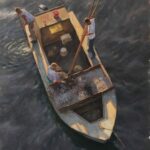
Getting exposure online.
There are more and more online shows now, like Raymar and of course the OPA. These are great because you can enter a piece that has sold and you don’t have the shipping expense.
Your work can be seen by thousands who may visit your website. If you don’t have a website today it is like going to a party and hiding under the table. I use Fine Art Studio Online and it has been great. Everybody today has a smart device that they can view art anywhere without physically being in the gallery.
National shows give the artist exposure, and the more you are visible, the more people can appreciate all the work that you have put into your paintings. Good Luck.
Classical (Classic) Realism – Part 2
“Traditional skills are necessary for developing a foundational base for the artist to work from. It is craftsmanship that opens the door to effective self-expression.” Juliette Aristides

In this three-part interview with Michael John Angel, Juliette Aristides, and David Hardy, I am hoping to define Classic Realism, its origins, its resurgence, and its importance to all of us.
Actually, I’m not explaining anything. All this is wonderfully done by these three living masters. If you haven’t read Part 1 of this series, I encourage you to do so before continuing. (Part I)
And now, Part 2 of “Classical (Classic) Realism”
I’ve heard some teachers refer to classical training for the artist as a “resurrection of the humanist spirit in western art”. What is meant by that?
Angel: I may be one of the people you are quoting here. Abstract art generally turn away from the world of people and doesn’t concern itself with the nature of Humankind, except for how to grab its attention. Representationalism concerns itself very much with the world of people and how people view nature – hence Humanism.
Aristides: I take it to mean that the figure is, once again, returning as a central subject in art. It is not only a shift in content but it represents a big philosophical shift as well.
Hardy: Art is returning to the speaking about the human condition and to the miracle of existence within which we find ourselves. Much of western art for over a century has devoted itself to such things as visual engineering and conceptual involvement.


What is your definition of art?
Angel: Art is wide; life is narrow (to paraphrase a Latin aphorism); this also is too big a question. I will say, though, that I believe a painting or sculpture should conjure an emotion in the viewer (it can be a mild one, or strong, lyrical or dramatic) and give the sense of the Eternal behind – the Specific.
Hardy: Art, like love, is more easily described than defined. Both could be expressions of the human soul, the human essence of being. But defining it? I leave that up to the experts.
How would you define beauty?
Angel: I wouldn’t even try. Beauty is much too wide a subject.
Aristides: The discussion about “what is beauty” has been going on for millennium. Any attempt to define beauty would be an act of hubris on my part – (however, that never stoped me before – so I will give it a shot:) Beauty in art is a reconciliation of opposing elements into a harmonious unity (between design, content and execution).
Hardy: Like trying to define love, defining beauty in words is beyond my powers. Identifying examples of visual beauty is more in my line.



What distinguishes classical training from other types of art instruction?
Angel: One has to learn specific skills in order to draw and paint realistically (there’s that word again!). These skills – how to make an even tone, how to measure, how to mix paints, how to create colour harmonies, how to model the illusion of form – can be taught, and are taught in the modern ateliers and academies. The state-run schools believe, rather naively, that art requires only passion and that the teaching of skill inhibits creativity. It is also true that many instructors in the state schools haven’t been taught well themselves and have no idea how to draw. There is a great (true) story of a life-drawing instructor in the Art Institute (I think) in Chicago, some years ago. It was nearly Christmas and most of his class had left for the holidays; he decided to draw along with the remainder of his students. After half an hour, he had made an awful mess and said, “This is harder than I thought!”. The life-drawing instructor in a prestigious university had never drawn the figure before.
Aristides: An Atelier is a studio run by a working artist (not an educator). An atelier provides a time-tested, progression of curriculum over period years – so that students reach a high level of technical proficiency. Drawing is taught first, then painting. Students often spend half days with the life model and the other half in their studio. In short it is a skill based traditional form of art education which places its emphasis on the student emerging as a fully trained artist able to open a studio of their own.
Hardy: Classical training involves the sharing of understanding and building of skills that constitute a visual language about reality. This is normally done in small classes with individual guidance. Advanced students in my Atelier when interested, are taught traditional procedures using layered glazing.



Why are we seeing such an interest in classical training for the artist at this time in our history?
Angel: People have always wanted to learn how to make representational drawings and paintings,and they always will. Fashion within the Art Establishment is starting to swing more and more towards Representationalism, and the new “Realists” are getting to be more visible; people are astonished and delighted to learn that this teaching is available to them. I cannot tell you how many letters and e-mails I receive, telling me that the sender thought that representational painting was “forbidden” today!! We are the avant-garde, and we are starting to have a voice – 45 years ago, when I was studying under Annigoni, there was only him, Gammell, signorina Simi and the Russian academies in Moscow and Saint Petersburg (there may have been one in China); now there are hundreds (thousands?) of good schools.
Aristides: We are living in an important time and need every tool available to fully express ourselves. One way that has been historically achieved is by looking back at our cultural legacy and building on it.
Hardy: Because we are maturing beyond rampant rejection of establishment ideas inherited from five hundred years of evolvement and refinement. We are recognizing the stupidity of believing “if it is new it must be better.”



Daniel Graves, founder of The Florence Academy of Art, also a living master and leader in the training of artists, talks about many of these same topics in a paper he wrote titled Tradition in the 21st Century.
He explains the difficulty of recapturing the “tradition” of past centuries.” Why can’t we produce Leonardos today? I do not believe it is just because we lack technical knowledge and expertise. I believe it is because there is something in addition to the technique that is also part of the tradition…the essence of the tradition. Given that we do not want to just repeat the work of past centuries, I think one of the great challenges we all face is that of discovering what we are going to paint and sculpt. The narratives that artists tapped into for centuries, the timeless stories from mythology and the Bible, seem less meaningful to people than they once did. To merely record the surface appearance of “reality” has never been the province of painting, whose language is far deeper. From the beginning, artists have painted, sculpted and drawn things that had meaning for them, and the images they have left behind are a living testament, a record of their consciousness on earth.”
Stay tuned for Part 3: the conclusion of “Classical (Classic) Realism”, in upcoming weeks.
For more on these important artists:
- Michael John Angel
- Angel Academy of Art
- Juliette Aristides
- Aristides Atelier at Gage Academy
- Aristides Atelier
- David Hardy
- Atelier School of Classical Realism
Other valuable related articles:
